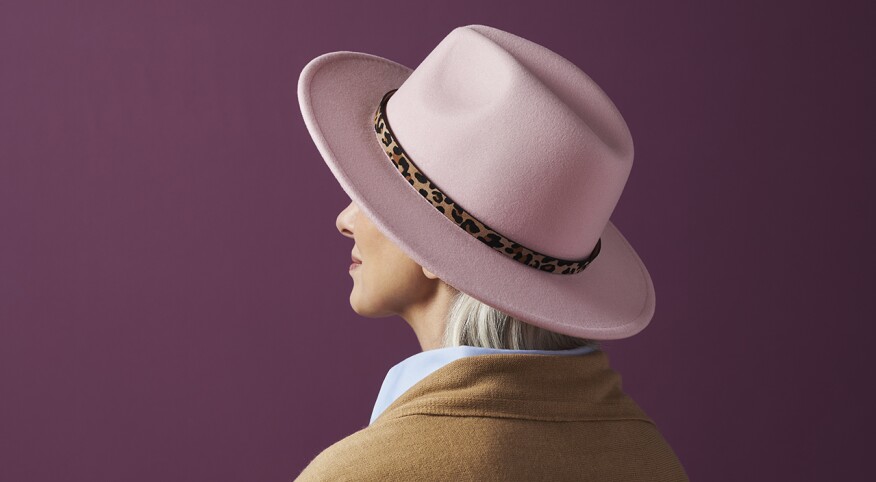Hats are back — though for people like me, they’ve never gone away. I’ve loved them since I was 4 years old, prancing around in my white bowler Easter hat, with red and yellow flowers around the brim. In my teens, I loved soft wool cloche beanies and large-brimmed straw hats that made me feel like a movie star.
Hats made me feel edgier and definitely better because they hid my prominent proboscis. I am now 63, and I still am adventurous in seeking out the trendiest and edgiest hats to wear. The hottest sellers for women of a certain age are soft knit hats that cling to the head, and wide-brimmed fedoras in cool pastels like dusty pink and baby blue, says Christina Dove, an e-commerce general manager who works for Hats in the Belfry, a sixth-generation hat store located in Baltimore and Annapolis, Maryland.
Dove, along with a small staff of 17, designs and sells hats to customers throughout the world. Hats in the Belfry has been around for the past 42 years and the staff keeps a sharp eye out for what’s trendy.
“People in their 60s and up buy a lot of wool and leather newsboy caps [caps with a bigger crown sort of like an undersized baseball cap], and fedoras,” Dove says. “But we find that hats are ageless. In spring and summer, the knit caps sell out equally with old and young people. It doesn’t matter the weather, it’s a great topper at all times of the year.”
For us girls in our 50s and up, Hats in the Belfry is selling out the porkpie hat, a circular hat with its brim turned up. Proving hats are ageless and timeless, in the 1920s, singer Josephine Baker made her signature hats, both cloche and tilted wide-brimmed styles — trendsetters that still reign today in the fashion industry. Multimedia artist Yoko Ono popularized the fedora.
For those riding their own ranges, the Stetson cowboy hat is still popular. “We curate the entire Stetson collection,” Dove says. “People wear Stetsons because they keep out the sun during the day but are warm at night. They can also be customized by shaping the brim.”
Beyond the trends, for many cultures hats mean history. In the African American community, ornate church hats have been worn by women for generations. These hats can be large and adorned with feathers, ribbons and bows — most in bright colors to match brightly colored suits and dresses.
“These are the hats that show who we are,” says Gail Hogan, a longtime churchgoer in the African American community. “We put our faith first, but we have style.”
Stylish churchgoers are not alone in their love of ornate head coverings. During the Victorian era, women wore bold, brimmed hats with flowers and large plumes. These toppers, called “bonnets,” were made of linen, straw, felt and other exquisite fabrics.
The important aspect of Victorian hat wearing was much the same as today: They covered your face from the sun. Back then, wearing hats kept your skin pale, and that represented wealth. Now, we know that hats can also help keep skin cancer at bay.
From Elizabethan times when they were a symbol to today’s desire to express individual style, hats are here to stay. A woman’s choice of hats can evoke many a mood, from mysterious to sexy, particularly accomplished with a velvet pillbox that comes with an eye-covering veil. Diane Keaton inspired legions of women in the 1970s through this day with her black felt Annie Hall hat. In the ’30s and ’40s, admirers of Greta Garbo copied her trademark beret. Audrey Hepburn could rock an unusual hat like no one else. In her role as Holly Golightly in a scene from Breakfast at Tiffany’s, she wore a mink hat by Givenchy.
Almost no one has inspired hat envy as much as Britain’s Queen Elizabeth with her toppers of mint green and lemon yellow — and other wild shades. Known for her pastel suits and matching hats since 1952, it’s estimated the queen has donned at least 5,000 different pieces of headgear during the past half-century.
For me, I love all hats whether they are felt, cotton or wool, from sharp fedoras to bucket-style cloches. Hat addicts like me come in all ages and sizes, though we are bound by these common traits: We’re a bit brash and unafraid. We’re not seeking attention. Attention is seeking us.
Jeannie Rapstad, president at Jeannie Rapstad Enterprises and a Purdue University professor, is well-known for her ever-growing collection of hats. She buys them everywhere and now has 115 styles in her closet. Her story about how she came to wearing hats is a little different from that of the average woman.
Rapstad didn’t get her advanced degree in English until she was age 69. When she started job hunting, she had to compete with much younger candidates.
“I went to a networking event and I overheard, ‘Who’s the old broad in the corner?’ and the old broad was me,” recalls Rapstad. To her next interviews, she wore a red bowler.
“Now people will start saying, ‘Who’s the classy dame in the hat?’ ” she says with a laugh.
At my age, I no longer care what people are saying about me. With or without the right hat, I feel feisty and free. Though the hat does help.

Mariana Juliano


